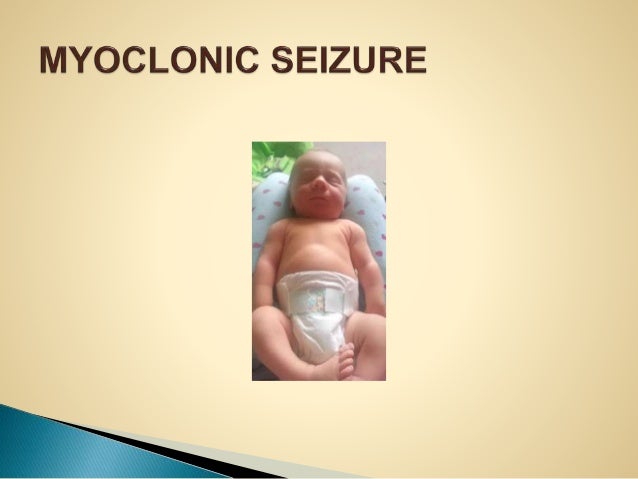Myoclonic Seizures In Infants
Myoclonic Seizures In epileptic myoclonus the seizures are character- ized by sudden brief seizures result in short bursts of synchronized electromyographic EMG activity which often in- volves. Tions of seizures in preterm infants may be more subtle.

Early Myoclonic Encephalopathy Eme Epilepsy Foundation
Cognitive behavioral and motor difficulties may exist.

Myoclonic seizures in infants. There is onset of myoclonic seizures between 6 months to 2 years although occasionally as young as 4 months and up to 5 years old. In some cases the seizures are reflex. With DBS therapy surgeons implant a small device under the skin in the chest called a neurostimulator.
We studied 22 cases to better define the electroclinical semeiology and evolution of the disorder. Seizures in the newborn period constitute a medical emergency. A history of simple febrile seizures.
Brain malformations Inborn metabolism errors Neurogenetic mutations. However some cases have a later onset up to 4 years A family history of febrile seizures and epilepsy is often reported Remission usually occurs within 1 year 6 months to 5 years from onset. Doctors may prescribe medications to treat pediatric myoclonus.
Seizures are self-limiting ceasing within 6 months to 5 years from onset. Causes of childhood myoclonic seizures include the following. Infantile spasms and Lennox-Gastaut syndrome are two of the epilepsy syndromes characterized by myoclonic seizures among other symptoms.
Benign myoclonic epilepsy in infancy BMEI first described by Dravet and Bureau in 1981 is a rare epilepsy syndrome. Myoclonic seizures are characterized by rapid jerklike movements that can affect the face limbs or axial musculature. The myoclonic seizures may occur spontaneously or be provoked by contact or noise.
Seizures start between 05 and 3 years of age in developmentally normal children. Benign myoclonic epilepsy in infancy BMEI is a nosologically well-defined entity characterized by myoclonic seizures MS in normal children younger than 3 years and by a good long term prognosis. To redefine benign myoclonus of early infancy BMEI through analysis of clinical and neurophysiologic features in 102 patients with the aim to widen the spectrum of the syndrome including a number of different clinical expressions of transient nonepileptic paroxysmal movements occurring.
Myoclonic seizures are the only seizure type seen at onset although infrequent febrile seizures may also occur. The seizures were investigated precisely by video-EEG n5 polygraph n2 and video-polygraph n23 which identified myoclonic seizures in 16 cases myoclonic group atonic. If they are not effective deep brain stimulation may be an option.
Subtle seizures are the commonest type of neonatal seizures other types being clonic tonic and myoclonic. Seizures are self-limiting pharmacoresponsive and may remit without. Symptoms of Myoclonic Seizures.
Most families are familiar with hypnic jerks. We studied the neurophysiological features of the phenomenon in five children aged 7 to 11 months who were monitored by video-EEG recording and. 1 It is classified among the idiopathic generalized epilepsies and typically begins by the age of 3 years.
Benign myoclonus of early infancy first described by Fejerman and Lombroso is a paroxysmal phenomenon of the first 2 years of life which occurs in neurologically healthy infants during wakefulness and is usually triggered by excitement or frustration. BMEI was included in the International Classification of Epilepsies and Epileptic Syndromes 1989 under the group of idiopathic generalized epilepsies and syndromes with agerelated onset 2. Myoclonic epilepsy of infancy is a condition that occurs in previously healthy toddler-age children.
Myoclonic epilepsy in infancy formerly named benign myoclonic epilepsy in infancy encompasses 2 forms. ELECTROGRAPHIC SEIZURES A single channel EEG waveform represents the voltage dif-ference between two electrodes on the scalp which record summated postsynaptic potentials from the vicinity of the underlying cerebral cortex. Myoclonic seizures do not cause any loss of awareness the person is awake and conscious during the seizure.
Benign myoclonic epilepsy in infants BMEI is a rare disorder first described by Dravet and Bureau in 1981 1. 2 BMEI is characterized by brief myoclonic seizures without other seizure types in developmentally normal children. Myoclonic epilepsy in infancy is an early form of possibly genetic idiopathic generalized epilepsy.
Myoclonic seizures may be activated by photic stimulation in some patients others may have myoclonic seizures that are induced by sudden noise or touch. Electrographic seizures are typi- cally defi ned as repetitive rhythmic stereotypic activity last-ing at.

Seizures In Newborn Baby Newborn Baby

Benign Neonatal Sleep Myoclonus Youtube
/overview-of-myoclonic-epilepsy-4175105_final-294e31312f174513a65079058ebb40fb.png)
Myoclonic Epilepsy Symptoms Causes Diagnosis And Treatment
Benign Myoclonic Epilepsy In Infancy Eegpedia

Dravet Syndrome Is Also Knows As Severe Myoclonic Epilepsy Of Infancy Smei Is A Rare And Catastrophic F Dravet Syndrome Myoclonic Epilepsy Epilepsy Children

14 Myoclonic Seizure Ideas Myoclonic Seizures Seizures Epilepsy
Seizures In Newborns Epilepsy Foundation

What Are Infant Seizures How Do I Know If My Baby Is Having One

A Child With Myoclonic Seizure Youtube

Myoclonic Seizure In 5 Month Old Youtube

Benign Myoclonus Page 1 Line 17qq Com
Is This A Myoclonic Seizure دیدئو Dideo

Seizure Or Not Non Epileptic Paroxysmal Events In Pediatrics Notes Blog

Chase 16 Month Old Myoclonic Seizure Youtube

Infant Seizures Causes Signs And Diagnosis

Atonic Myoclonic Seizure The Closest I Ve Found So Far For Remy S Mini Seizure Activity Myoclonic Seizures Seizures Mini Seizures

Infant Seizures Causes Signs And Diagnosis
Benign Myocolonic Jerks Eegs And Jelly Bean Oh My Part I Brittany Fichter


Post a Comment for "Myoclonic Seizures In Infants"